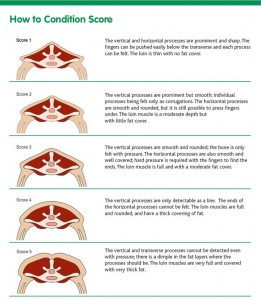Welfare Assessment
 Visit our Animal Welfare Assessment page to find out more about welfare assessment and visit the AssureWel website for practical information on assessing the welfare of sheep. Compared to other farm animal species, there are few validated animal-based measures of sheep welfare have been developed.
Visit our Animal Welfare Assessment page to find out more about welfare assessment and visit the AssureWel website for practical information on assessing the welfare of sheep. Compared to other farm animal species, there are few validated animal-based measures of sheep welfare have been developed.
There are opportunities to use qualitative judgements of behaviour (Wemelsfelder and Farish, 2004) and quantitative animal-based measures (Phythian et al., 2010). The table below highlights the measures that the AssureWel project has identified as being important to sheep welfare.
| Individual measure | 1. Lameness |
| Flock measures | 2. Body Condition Score (see chart on right) 3. Dirtiness 4. Fleece loss 5. Skin irritation 6. Sheep needing further care 7. Mutilations 8. Ear integrity 9. Response to stockman |
| Records measures | 10. Mortality 11. Health and welfare planning and management a. Lameness – verifying self-assessment and management b. Body Condition Score – verifying self-assessment and management c. Mastitis d. Faecal egg count testing |


 American English
American English


Comments are closed.